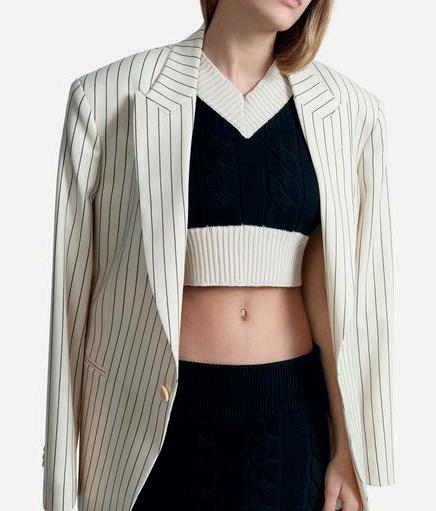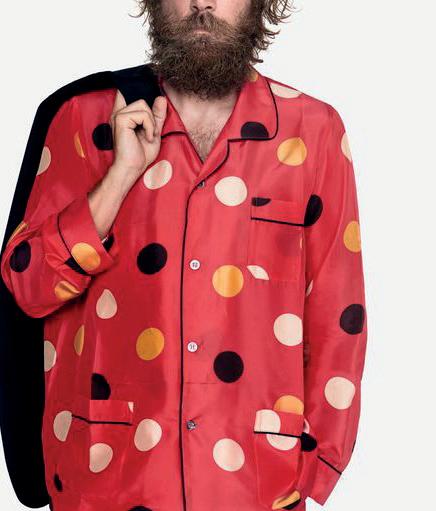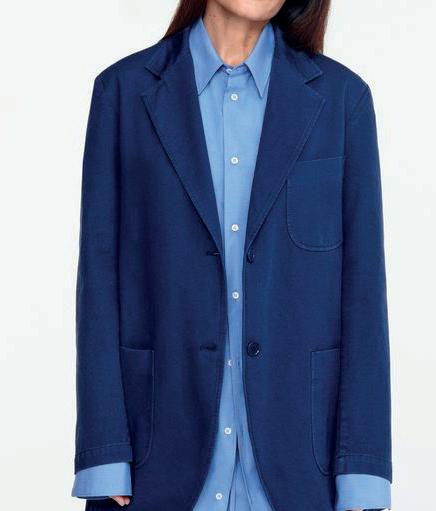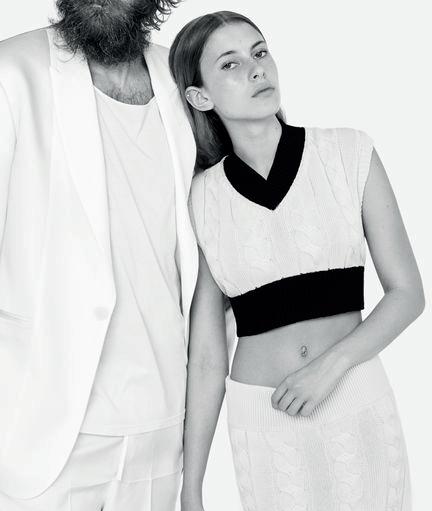
10 minute read
ASPESI: THE MINIMALISM OF ELEGANCE
from GATEmag - n° 31
by GATEmagIta
From the quilt to the “total look” of one of the most representative brands of Made in Italy
Tra i tanti brand che possono vantare l’essere rappresentativi del Made in Italy ce n’e uno che spicca rispetto agli altri, parliamo di Aspesi azienda fondata da Alberto Aspesi nel 1969, nata a Legnano in Lombardia inizialmente per produrre camicie ma nel tempo si è specializzata nella creazione di collezioni total look uomo/donna, diventando un vero punto di riferimento del prét-a-porter italiano. Negli anni 70 per quanto riguardava la moda e le sue tendenze i punti di riferimento erano tutti oltralpe ed esattamente a Parigi dove l’Haute Couture determinava le regole stilistiche a livello internazionale, ma i brand italiani e soprattutto Aspesi iniziarono a puntare sulla ricerca dei materiali, ridisegnando un nuovo concetto di eleganza e rivedendo le proporzioni di una nuova vestibilità, una nuova estetica stava affacciandosi all’intero sistema moda determinandone il cambiamento, Aspesi in questo senso è stato uno dei primi brand capaci di avviare questo nuovo approccio dove eleganza, ricerca e proporzioni ridisegnavano il nuovo concetto di vestibilità e moda.
Saranno le visioni di alcuni stilisti a dare forza al brand che si nutrirà delle intuizioni di creativi come Franco Moschino, Walter Albini e Marco Zanini questi daranno nuova linfa creativa ed una visione moderna e incontaminata da quegli elementi statici e superati tipici della moda francese, proprio durante una chiacchierata di confronto tra Alberto Aspesi e Franco Moschino che nascerà il primo piumino dalle linee minimal, una nuova vestibilità si affaccia sul panorama mondiale con un’attenzione spasmodica alla ricerca dei tessuti e dei nuovi materiali che faranno diventare in breve tempo questo capo d’abbigliamento l’oggetto più iconico della maison. Aspesi ha un nuovo modo di interpretare la moda rispetto a quello che le altre maison sviluppano, una visione non convenzionale e un innovativo metodo di raccontare la propria storia e i propri prodotti, questo avviene attraverso la scelta di collaborare con fotografi internazionali capaci di cogliere al meglio la filosofia del brand, tra questi citiamo i grandi Peter Lindberg, Oliviero Toscani e Paolo Roversi che sono stati capaci non solo di raccontare al meglio la visone del brand ,ma anche d’interpretare la sua passione per l’arte e l’architettura che traspare non solo nelle campagne pubblicitarie ma anche nelle linee stilistiche di tutte le collezioni, Lindberg ad esempio scatterà la campagna pubblicitaria sulle coste americane di Palm Springs dove le protagoniste saranno 2 top model del calibro di Linda Evangelisti e Christy Turlington, bellezza e leggerezza saranno la nuova visione della moda della maison lombarda.

Ancora oggi il minimalismo e la super eleganza sono parte integrante e viva dello stile di Aspesi che riesce in modo unico ed esclusivo ad avere una personalità chiara e riconoscibile fedele al proprio Dna pur rinnovandosi anno dopo anno conquistando le preferenze dei consumatori di tutto il globo. Ad interpretare lo stile di Aspesi è lo stilista Lawrence Steele che già in passato aveva collaborato come creativo della linea femminile, invece dal 2020 diventerà il Direttore Creativo di tutte le collezioni della maison, il designer americano vanta nel suo curriculum vitae un passato in Marni, Prada e Moschino, che contribuiranno ad alimentare il suo estro creativo che porterà inesorabilmente all’interno della maison di Legnano, coniugando al meglio ricerca tessile e design. Nel 2017 Aspesi viene acquistato dal private equitty italiano Armonia SGR che darà nuove risorse economiche e riporterà a casa come sopra dichiarato uno dei suoi creativi più sensibili e capace di dare continuità allo stile unico della maison, creando abiti dall’inconfondibile vestibilità capaci di durare nel tempo.
Durante le presentazioni alla stampa noi di Gate abbiamo avuto il piacere di essere invitati nel negozio Aspesi di Milano dove abbiamo visto le nuove collezioni e chiacchierato con collaboratori del brand e il loro ufficio stampa per scoprire qualcosa in più dell’evoluzione di uno dei brand più rappresentativi del nostro Made in Italy.
Chi sono gli uomini e le donne Aspesi? Sicuramente persone autentiche e fedeli a se stesse, con una grande personalità e nella maggior parte dei casi persone pure. ASPESI è un brand autentico, forte di un pragmatismo che lascia intravedere un senso molto profondo di intimità nel proprio racconto. I capi di ASPESI compongono un vero e proprio guardaroba di funzioni d’uso, pensati per essere trasversali, intercambiabili. Ci piace pensare che la stessa giacca che ieri indossava il nonno e che per lui rappresentava un senso di autorità e sicurezza, oggi sia indossata dalla nipote, che interpreta il capo in chiave più ribelle e libera. In questo senso, il guardaroba aiuta le persone ad esprimere al meglio la propria personalità ed autenticità, senza soffocarle. Il piumino è stato il primo capo di successo del vostro brand, come è evoluto nel tempo?
La storia di ASPESI è permeata di episodi legati alla funzionalità. Come quello legato al piumino. Il brand è stato il primo a introdurre il piumino, fino ad allora considerato un capo puramente tecnico, come elemento di un guardaroba più urban e trasversale. L’idea nasce durante una chiacchierata tra Alberto Aspesi e Franco Moschino, che diede il suo nome alla giacca.
I capispalla tecnici sono poi diventati capisaldi del guardaroba ASPESI e si legano al binomio tra la realizzazione di capi iconici, senza tempo, e la costante ricerca di materiali innovativi e inaspettati.
Quali sono i tessuti più usati per realizzare i vostri capi?
Il nylon è certamente un tessuto iconico per il brand, ma in generale ci riguardano tutti i tessuti pregiati: Aspesi utilizza tessuti di alta qualità come lino, seta, cashmere e lane pregiate per creare capi di abbigliamento senza tempo e confortevoli.

Aspesi è nell’immaginario comune un brand invernale ma avete una bellissima collezione estiva ne vogliamo parlare?
L’estetica Aspesi è classica, elegante e senza tempo ed è rimasta popolare per decenni. I design del marchio sono pensati per essere indossati negli anni e sono una testimonianza del fascino duraturo del classico stile italiano.
Ogni collezione incorpora però nuovi elementi nel guardaroba, aggiornandolo con stampe, tessuti e tagli dedicati alla stagione.
Nella primavera estate vi è un richiamo alle stampe che evocano l’estetica della vacanza. I look della collezione mixano poi elementi apparentemente distopici, come paillettes e nylon, che convivono in accostamenti dai colori pastello, smorzati da classiche camicie in lino, il brand è capace di soddisfare ogni esigenza legata alla stagionalità.
Avete un archivio molto importante, ci sono dei capi iconici che sono stati importanti e diventati nel tempo fonte ispiratrice?
I design ASPESI presentano spesso silhouette eterne, come giacche dal taglio morbido, pantaloni dritti, camicie classiche e capispalla in nylon. Queste forme senza tempo sono progettate per valorizzare una vasta gamma di fisicità e non passare mai di moda. Possiamo citare i “Fundamentals” che riassumono i valori del brand di pragmatismo, vestibilità, essenza, veri e propri capi iconici d’archivio ASPESI: Pinguino, Gabetta, Orso, Magenta, Moschino, Piumino, Gilet piuma, Field Jacket...
Negli anni 80 avere un capo Aspesi significava un vero status symbol, questa azienda è stata capace di creare capi d’abbigliamento capaci d’interpretare in pieno il cambiamento che la moda stava vivendo in quel periodo, abiti e giubbotti dalla duplice funzionalità a seconda di come venivano indossati e in quale occasione.
Giubbotti in nylon e velcro capaci di contribuire ad aumentare l’eleganza se indossati sopra un abito elegante e formale per andare al lavoro o per qualche evento mondano importante, ma altresì funzionali e pratici se indossati sopra i jeans ed un maglione di cachemire per una sfrecciata in moto oppure un pomeriggio allo stadio, questo nuovo modo di approcciare la moda è stato il punto di forza di questo brand che oggi unisce generazioni lontane l’una dall’altra ma con le medesime esigenze, eleganza, vestibilità, adattabilità e glamour.

Paris where Haute Couture determined stylistic rules at an international level, while Italian brands and above all Aspesi, began to focus on researching materials , redesigning a new concept of elegance and reviewing the proportions of a new fit as a new aesthetic was appearing in the entire fashion system influencing its change. In this sense, Aspesi was one of the first brands capable of starting this new approach where elegance, research and proportions redesigned the new concept of wearability in fashion.
The visions of certain stylists gave strength to the brand which fed on the intuition of creatives such as Franco Moschino, Walter Albini and Marco Zanini who gave new creative lifeblood with a modern and uncontaminated vision from those static and outdated elements typical of French fashion. During a discussion between Alberto Aspesi and Franco Moschino, the first down jacket with minimal lines was created and a new wearability emerged on the international scene with intense attention to the research of fabrics and new materials that quickly made this garment the most iconic object of the maison.
Aspesi has a new way of interpreting fashion compared to what the other maisons develop, an unconventional vision and an innovative method of telling its story and its products, occuring by the choice to collaborate with international photographers capable of capturing the best philosophy of the
EN Among the many brands that can boast being representative of Made in Italy, there is one that stands out from the others. Aspesi, a company founded by Alberto Aspesi in 1969, born in Legnano in Lombardy, initially produced shirts but over time became specialized in the creation of men’s/ women’s “total look” collections, becoming a true point of reference for Italian prêt-a-porter.
In the 1970s, as far as fashion and its trends were concerned, reference points were beyond the Alps and precisely in brand. Among these we can mention the great Peter Lindberg, Oliviero Toscani and Paolo Roversi who were able not only to describe the vision of the brand, but also to interpret its passion for art and architecture that shines through not only in the advertising campaigns but also in the stylistic lines of all the collections.

For example, Lindberg shot the advertising campaign on the American coasts of Palm Springs where the protagonists were 2 top models of the caliber of Linda Evangelisti and
Christy Turlington; beauty and lightness was the new vision of fashion from the Lombard maison.
Even today, minimalism and super elegance are an integral and living part of Aspesi’s style which manages, in a unique and exclusive way, to have a clear and recognizable personality faithful to its DNA while renewing itself year after year, and conquering the preferences of consumers from all over the globe. Interpreting Aspesi’s style is stylist Lawrence Steele who in the past had already collaborated as creative for the women’s line. In 2020 he became the Creative Director of all the collections of the maison. The American designer boasts in his curriculum vitae a past in Marni, Prada and Moschino, which helped fuel his creative flair which he inexorably brings into the Legnano maison, combining textile research and design in the best possible way. In 2017 Aspesi was bought by the Italian private equity firm Armonia SGR which gave them new economic resources and brought home one of its most sensitive creatives while being able to give continuity to the unique style of the maison creating clothes with an unmistakable wearability capable of lasting the test of time.
During the press presentations we at Gate had the pleasure of being invited to the Aspesi store in Milan where we saw the new collections and chatted with brand collaborators and their press office to find out more about the evolution of one of the most representative of Made in Italy.
Who are the Aspesi men and women?
Definitely authentic people and true to themselves, with a great personality and in most cases pure people. ASPESI is an authentic brand, strong in pragmatism that reveals a very deep sense of intimacy in its story. ASPESI garments make up a veritable wardrobe of functional uses, designed to be transversal, interchangeable. We like to think that the same jacket that grandfather wore yesterday and which for him represented a sense of authority and security, is now worn by his granddaughter, who interprets the garment in a more rebellious and free way. In this sense, the wardrobe helps people to best express their personality and authenticity, without suffocating them.
The down jacket was your brand’s first successful garment, how has it evolved over time?
The history of ASPESI is permeated with episodes related to functionality. Like the one tied to the duvet. The brand was the first to introduce the down jacket, until then considered a purely technical garment, as an element of a more urban and transversal wardrobe. The idea was born during a chat between Alberto Aspesi and Franco Moschino, who gave his name to the jacket.
The technical outerwear then became cornerstones of the ASPESI wardrobe and are linked to the combination between the creation of iconic, timeless garments and the constant search for innovative and unexpected materials.
What are the most used fabrics to make your garments?
Nylon is certainly an iconic fabric for the brand, but in general we are all concerned with fine fabrics. Aspesi uses high quality fabrics such as linen, silk, cashmere and fine wools to create timeless and comfortable garments.
Aspesi is a winter brand in the common imagination but do you have a beautiful summer collection and shall we talk about it?
The Aspesi aesthetic is classic, elegant and timeless and has remained popular for decades. The brand’s designs are meant to be worn through the ages and are a testament to the enduring appeal of classic Italian style.
However, each collection incorporates new elements into the wardrobe, updating it with prints, fabrics and cuts dedicated to the season.
In spring summer there is a reference to prints that evoke the aesthetics of the holiday. The looks of the collection then mix apparently dystopian elements, such as sequins and nylon, which coexist in pastel-colored combinations, toned down by classic linen shirts. The brand is capable of satisfying every need related to seasonality.
Do you have an important archive? Are there any iconic garments that have been important and have become a source of inspiration over time?
ASPESI designs often feature timeless silhouettes, such as relaxed fit jackets, straight trousers, classic shirts and nylon outerwear. These timeless shapes are designed to flatter a range of body shapes and never go out of style. We can mention the “Fundamentals” which summarize the brand’s values of pragmatism, wearability, essence, real iconic items from the ASPESI archive: Pinguino, Gabetta, Orso, Magenta, Moschino, Piumino, Gilet feather, Field Jacket...
In the 80s having an Aspesi garment meant a true status symbol, this company was able to create clothing capable of fully interpreting the change that fashion was experiencing in that period, suits and jackets with dual functionality depending on how they were worn and on which occasion. Nylon and Velcro jackets able to help increase elegance if worn over an elegant and formal dress to go to work or for some important social event. But also functional and practical if worn over jeans and a cashmere sweater for a dash on a motorbike or an afternoon at the stadium. This new way of approaching fashion has been the strong point of the brand which today unites generations with the same needs, elegance, wearability, adaptability and glamour.









